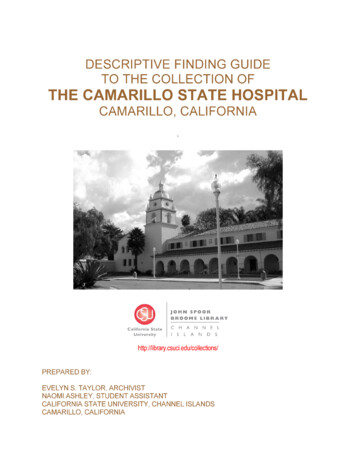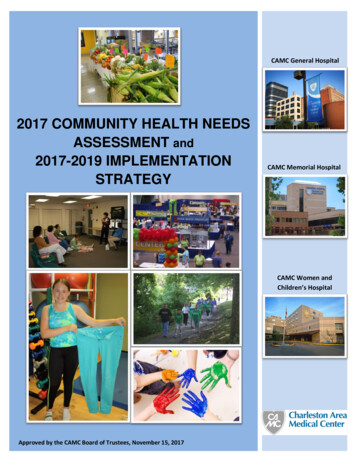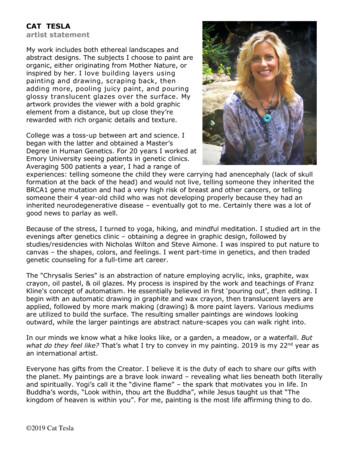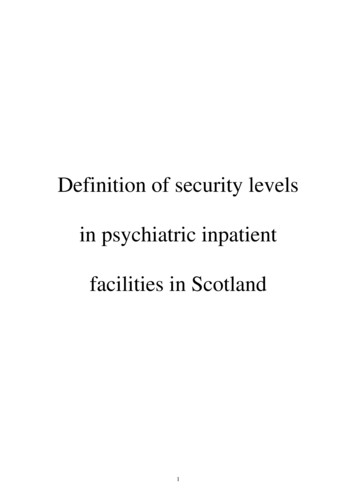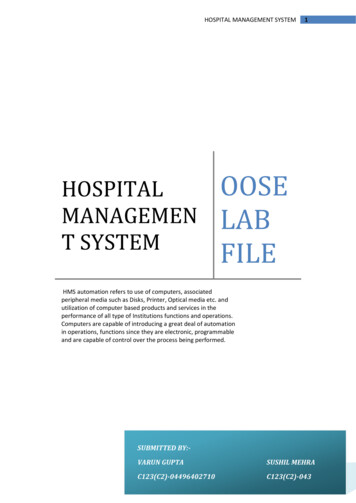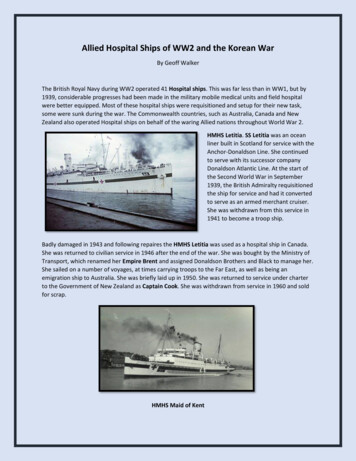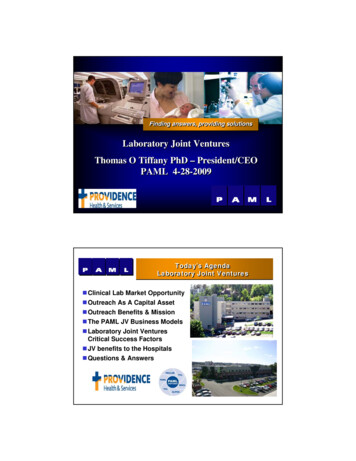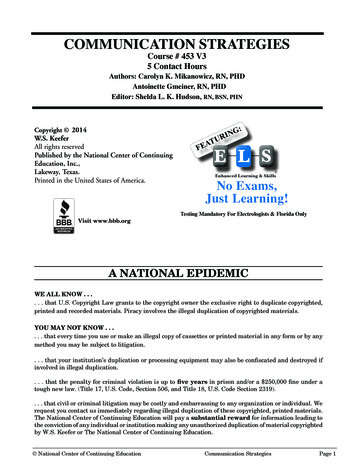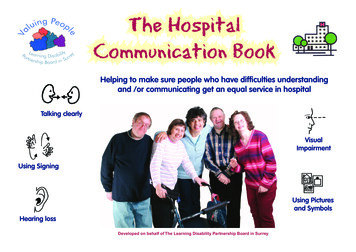
Transcription
The HospitalCommunication BookHelping to make sure people who have difficulties understandingand /or communicating get an equal service in hospitalTalking clearlyVisualImpairmentUsing SigningUsing Picturesand SymbolsHearing lossDeveloped on behalf of The Learning Disability Partnership Board in Surrey
Introduction and ContentsThis communication book has been developed on behalf of The Learning Disability Partnership Board in Surrey.The Partnership Board funded the Access To Acute Hospitals Project which aimed to help make sure that people with alearning disability had the right support when they used acute hospital services. The biggest barrier to people receiving theright support was found to be communication. This book aims to help hospital staff in 2 ways, and contains 2 sections. Section 1 - To give acute hospital staff basic information about the communication needs people may have Section 2 - To be a practical communication tool people can use to help communicate together.Section 1 - Information PagesSection 2 - The Picture, Symbol, Photo Toolkit Page 3 - Communicating with speech Page 9 - Drinks Pages 16, 17, 18 - Procedures Page 4 - Supporting people with visual impairments Page 10 - Food Pages 19 & 20 - Body parts Page 5 - Supporting people with a hearing loss Page 11 - People Page 21 - Full Body Page 6 - Using Signing Page 12 - Personal things Page 22 - Nil by Mouth Page 7 - Examples of useful signs Page 13 - Personal care Page 23 - Places Page 8 - Using photos, pictures, and symbols Page 14 - Symptoms Page 24 - When Do I Go Home ?These pages aim to explain some of the keycommunication issues for people with learningdisabilities. Also to give you advice and practical tipson how to communicate clearly with people withlearning disabilities, and other people who may havedifficulties communicating. Page 15 - Degree of PainThese are practical pages of pictures you can use to offer people choices, explain topeople what is going to happen, and help them to communicate to you. Please readpage 8 before using the pictures with people as this gives important advice on how touse them. Bear in mind not everyone will be able to recognise the meaning of all thepictures. They can help to back up what you are saying, and clue people in.We are keen that you use this book in anyway you feel can improve a person’sexperience whilst in hospital. You may find it useful to photocopy some of the pages touse seperately. For example the ‘Nil by Mouth’ page can be copied to be displayed abovea person’s bed. To respect the copyright of Rebus, PCS, Makaton, Change Picturebankand Photosymbols graphics please do not reproduce these pages for any other purposes.The Hospital Communication BookDeveloped on behalf of The Learning Disability Partnership Board in SurreyWidgit Rebus symbols used with permission from Widgit Software Tel: 01223 425558Many thanks to theBuilding Links Groupfrom BentleyDay service for helping tochoose the symbols used.Page 2
Communicating Clearly with SpeechWe usually talk too fastPeople don’t understandall the words we useUse very Literal LanguageWhen people are talking to us weunderstand much of their meaningby their tone and body language.Also, we often talk using abstractphrases rather than accuratewords. Look at these phrases.I’ll give you a bell laterIt takes more time for many peopleto process the words they hear.This is true for many peoplewith a learning disability.And also true for all peoplewhen they are feeling anxiousUse everyday words wherever youcan. Use short simple sentences.Have only one idea in a sentence.You may have a much largervocabulary than the person youare communicating withSome people with a learning disability may only pick up key words in a sentence. Thismeans they may only take in one, two, or three words of your sentence. For example :Unfortunately dueto complicationsit‛s not possiblefor you to gohome yet, wemay know moretomorrowhometomorrowThe doctor’s doing her roundsHe can’t see the wood for the treesSome people will be less skilledat interpreting abstract language.They take a more literal meaningfrom words, and can get confused.Using gestures helpsIt’s important tomake sure theperson hasunderstood themain idea ofyour messageDON’T SHOUT - IT’S RUDE, AND DOESN’T HELP COMPREHENSION !!!!The Hospital Communication BookDeveloped on behalf of The Learning Disability Partnership Board in SurreyGestures and facialexpressions givevisual clues aboutthe meaning of whatyou are saying, aswell as slowingdown the pace ofyour speechPage 3
Supporting People with Visual Impairments“In the UK 17,000 people with sight problems use a white cane. Another 5000use guide dogs. There are many more who need help with their everyday living”.Be aware how you explain things.We often talk in a very visual way.For example when asked wherethe toilet is “the green door on theright” is not a helpful answer! If youare physically shown you can workthe route out for yourself.There are around 23,000people in the UK whohave a severe loss ofboth sight and hearing.About 200,000 haveless serious dualsensory loss.To make hand writing more legible,choose a dark felt tip pen andwrite neatly using thicker strokes.Be aware that some people havegood vision in a limited area sowould be ok with smaller print.Avoid clutter! Try to minimise therisk of someone tripping over thingsIt’s important to take the time to tell people where theimportant things are like toilets, call buttons, and drinks.People may need a bit of time before they are confident. Itcan help people to have a bed near a landmark in the room,say a bed at the end rather than in the middle.Good lighting is important. A clip on readinglamp may be useful for a person to have.A magnifying glass may be useful to have around theward for people who have a visualimpairment to use to read.Be aware that people have a varietyof sight difficulties and a magnifiermay not meet their needs.Encourage people to bring in their own magnifier.Menus and food are a very common difficulty for people with sight problems in hospitalPeople will often have difficulty reading and ticking the menus as they are usually printed in verysmall writing. Read the menu out for someone or enlarge in on the photocopier if someone readslarge print. Meals may be left on a tray, on a table, which is out of reach near the end ofthe bed. Someone who has a visual impairment may not see the meal and miss their food. It’simportant that staff take the time to describe to the person what is happening & where things are.The Hospital Communication BookDeveloped on behalf of The Learning Disability Partnership Board in SurreyPage 4
Supporting People with a Hearing LossFirstly, establish how the deaf person communicates.If they are asking you a question using their voice, it is safeto assume that they will be expecting to lip-read your reply. Face the person directly, if you look awaythe deaf person cannot see your lips. Speak clearly at a normal pace. Do not shout Make sure you have good light on your face so theperson can see your features and read your lips easily. Use whole sentences rather than one word replies lip-reading is 70% guess work and many wordslook the same. Using sentences gives contextual clues. Be patient, if you are asked to repeat something trychanging the sentence slightly, it may make it easierto understand.Mime driving a car to ask if you can give them a lift. Pointto objects to give clues, or point to give directions. Showsize and shape with your hands Use facial expressions to help convey meaning. Fingerspelling - Deaf people usually fingerspell names,places, and unusual words.If the person has a learningdisability and a hearing loss thenplease note this general adviceabout hearing loss, but also allow forthe person’s learning disabilitysee advice on page 3. Do not give up, if you cannot make yourselfunderstood then try writing it down or drawingwhat you mean. If the person is a sign language user, they willprobably still expect to have to try to lip-read yourreply. Very few hearing people sign, and deaf peopleare used to trying to communicate with hearing people. Use gestures to help explain what you are saying.Use gestures, point, mime to help explain what you aresaying. E.g. Show a cup and ask what they want to drink.The Hospital Communication BookDeveloped on behalf of The Learning Disability Partnership Board in SurreyPage 5
Using Signing To Support SpeechThe main benefit of using signingwith speech is that it makescommunication visual.People can see what you aresaying as well as hearing it.People then have more ways ofunderstanding the message.British Sign Language (BSL)Is a full visual language usedby many deaf people tocommunicate. Not everyone whosigns uses the full BSL.Some people use signs to supportthe words they are speaking. Manypeople who aquired a hearing losslater in life use signing in this way.A deaf person may need thesupport of an interpretor. Contactyour local Deaf Services TeamOn the following page we have included diagrams of a few signs you may finduseful on a hospital ward. These are signs for things not easily represented by apicture or symbol. It’s best to use the symbols where you canSome signs have anarrow which shows youthe direction to moveyour hand. The doubleheaded arrow heremeans up and down.A morespecificaction isexplainiedin writing.Makaton SigningMakaton is a language programmeintegrating speech, manual signs,and graphic symbols. Many peoplewith a learning disability useMakaton. Key words are signed.To explain that you are going for a drive you might say‘we are going in the car’ as it keeps the language simple.The limitation of signing is that, as with speech, when you stopsigning the message is gone and relies on the person’s memory.The Hospital Communication BookDeveloped on behalf of The Learning Disability Partnership Board in SurreyWe are going to theshop in the car.You only sign the bold words.Contact Makaton for advice ontraining. Their website iswww.makaton.orgPage 6
Some Useful Makaton SignsEatDrinkToiletHouse - often usedfor homeSleepPainYesNoPleaseThank YouGoodBadPlease Note : These signs are for illustration. People learn Makaton signing in groups supported by Makaton representatives.Please go to www.makaton.org.for more informationThe Hospital Communication BookDeveloped on behalf of The Learning Disability Partnership Board in SurreyPage 7
Using Photos, Pictures, and SymbolsMany people who have alearning disability will befamiliar with some symbolsPhotos, Pictures and symbolscan help people to:Understand InformationMany people with a learning disability donot read, and some people find it hard tounderstand when you explain things.Pictures can help get your message across.carheadacheNote of CautionTell you what they needSome people with a learning disabilitydo not communicate verbally. Somepeople ‘s speech can be hard tounderstand. Pictures can help themget their message acrossMake choicesMany people find it hard to makechoices in their head. Havingpictures to look at helps.A picture, photo, or symbol is only a 2 dimensional representation ofan object or idea. Not all people with a learning disability will take ameaning from a picture, photo, or symbol.Some people have a very profound disability and do not use picturesand symbols at all. Using an object, like a cup or a gown, can helpto explain what you’re saying.Many symbols look like what they represent - others are moreabstract. If you can’t easily tell what a symbol represents other peoplewill struggle too, and will need help. Remember that many peoplewon’t be able to read the word underneath.Some people will understand the symbol for car easily but maystruggle with headache which is more abstract.One benefit of using pictures is that they arepermanent. Once you stop speaking or signing yourely on the person’s memory.The symbols we have included on the next few pages may helpyou to communicate more clearly with a wide range of people.The Hospital Communication BookSymbols are simple line drawingsthat represent a wordSymbols and SigningNot everyone who uses signing will be familiar withsymbols and not everyone who understands symbols willunderstand signing. Some people will use a mixture of both.Developed on behalf of The Learning Disability Partnership Board in SurreyPage 8
Symbols of DrinksTeaCoffeeMilkSugarLemonOrangeHot ChocolateFizzy DrinkSquashBlackcurrantRed FruitsMilkshakeThe Hospital Communication BookWaterJuiceDeveloped on behalf of The Learning Disability Partnership Board in SurreyLimePage 9
Symbols of ateCakeCerealToastBiscuitCrispsThe Hospital Communication BookDeveloped on behalf of The Learning Disability Partnership Board in SurreyPage 10
Symbols of rPartnerGrandadGrandmaFriendThe Hospital Communication BookDeveloped on behalf of The Learning Disability Partnership Board in SurreyPage 11
Symbols of Personal ThingsGlassesHearing rWalking FrameWalking StickShoes & slippersThe Hospital Communication BookDeveloped on behalf of The Learning Disability Partnership Board in SurreyPage 12
Personal Care SymbolsShowerWashBathToiletShaveBrush teethBrush hairDressing GownToiletriesMake upSanitary wearThe Hospital Communication BookDeveloped on behalf of The Learning Disability Partnership Board in SurreyHairwashPage 13
Symbols of SymptomsHotColdHeadacheBackacheTummy AcheSore throatChest PainConstipationDiarrhoeaTiredSickThe Hospital Communication BookDeveloped on behalf of The Learning Disability Partnership Board in SurreyDizzyPage 14
Degree of PainHappyThe Hospital Communication BookOKIn PainDeveloped on behalf of The Learning Disability Partnership Board in SurreyBad painPage 15
Symbols of castTabletsMedicineSling75Mouth careThe Hospital Communication BookNail carePulseDeveloped on behalf of The Learning Disability Partnership Board in SurreyBlood PressurePage 16
Symbols of ProceduresScanDripCanulaultrasound scanEndoscopySigmoidoscopyHeart Monitor / ECGNaso-gastric tubeUrine TestThe Hospital Communication BookDeveloped on behalf of The Learning Disability Partnership Board in SurreyCatheterEEGOperationPage 17
Symbols of ProceduresBlood TestBlood testStitchesX rayInjectionInjectionThe Hospital Communication BookSuppositoryChairDon’t walkDeveloped on behalf of The Learning Disability Partnership Board in SurreyEnemaSymbolsforMovingStay in bedPage 18
Body ChestBreastsThe Hospital Communication BookDeveloped on behalf of The Learning Disability Partnership Board in SurreyPage 19
Body ToeFingerThe Hospital Communication BookDeveloped on behalf of The Learning Disability Partnership Board in SurreyPage 20
Full BodyBackFrontThe Hospital Communication BookDeveloped on behalf of The Learning Disability Partnership Board in SurreyPage 21
Nil By MouthNo DrinkThe Hospital Communication BookNo FoodDeveloped on behalf of The Learning Disability Partnership Board in SurreyPage 22
Symbols of PlacesWardHomeTransportTV RoomCafeChapelGardenDay CentreShopThe Hospital Communication BookNewspapers and MagazinesFlowersSnacksDeveloped on behalf of The Learning Disability Partnership Board in SurreyDrinkPage 23
When do I go home ?Monday7 nightsTuesday6 nightsThe Hospital Communication BookWednesday5 nightsThursday4 nightsSaturdaySunday2 nightsHome1 nightFriday3 nightsDeveloped on behalf of The Learning Disability Partnership Board in SurreyPage 24
British Sign Language (BSL) Is a full visual language used by many deaf people to communicate. Not everyone who signs uses the full BSL. Some people use signs to support the words they are speaking. Many people who aquired a hearing loss later in life use signing in this way. A de
